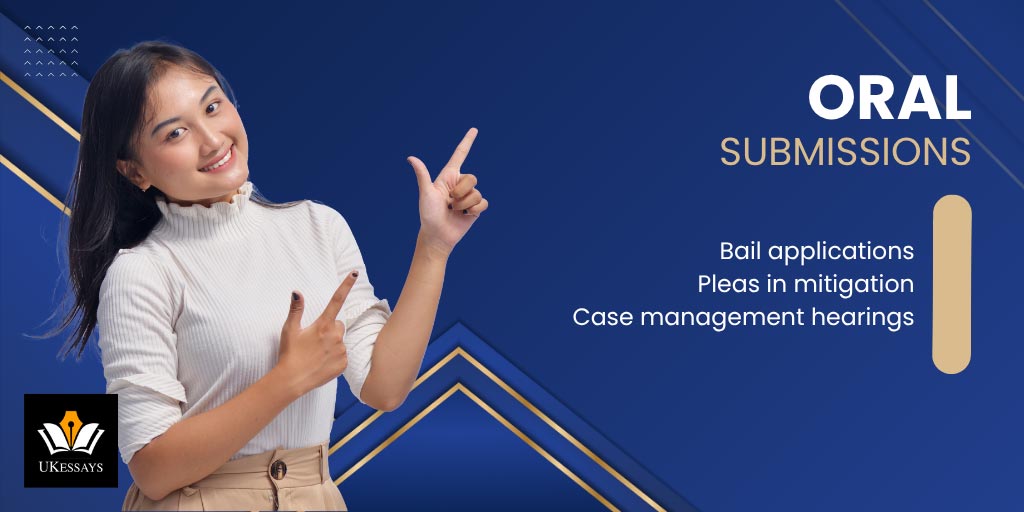Advocacy and oral submissions: training verbal communication and argument structure
Info: 4869 words (19 pages) Study Guides
Published: 28 Jul 2025

For help from a qualified member of our legal team with drafting oral submissions or other types of assignment, see our law assignment help page.
Advocacy exercises focusing on oral submissions are designed to train law students and junior lawyers in effective verbal communication and structured argumentation. These exercises typically occur in a mock courtroom setting, simulating real hearings to develop courtroom skills. They are central components of vocational training programmes. This is especially true in the Bar training course (formerly BPTC) and the Legal Practice Course (LPC). They are also commonly encountered in mooting or student competitions at the undergraduate level. The purpose is to cultivate confident, clear and persuasive advocates who can think on their feet.
As Myerson and Engineer (2019) note, a fine advocate must be more than a “good talker”. Success hinges on mastery of the law, careful preparation, and command of the facts. It also requires the ability to adapt one’s style to the audience. Indeed, thorough preparation lies at the heart of effective advocacy. Advocates are expected to be experts in the relevant procedures and rules of evidence (Myerson and Engineer, 2019). In practical terms, this means learning to structure each type of oral submission in a logical way.
At the same time, the advocate must maintain an engaging and professional delivery. This guide explores three common advocacy scenarios: bail applications, pleas in mitigation, and case management hearings. It outlines the purpose of each and offer guidance on how to excel in each. Throughout, we emphasise active communication, sound argument structure, and proper courtroom etiquette.
Before examining each scenario in depth, it is worth outlining some general principles of oral advocacy. First, thorough preparation is essential for any oral submission. Advocates must digest their case materials and identify the key issues and evidence well in advance. They should know the case inside out and anticipate areas of weakness or likely questions. Preparation includes researching the relevant law and procedural rules for the specific type of hearing. A good advocate must apply the law accurately to advance their client’s position (Law Society, 2025).
Secondly, an advocate should structure their submissions clearly. A logical structure is crucial. For example, the advocate might begin by stating the desired outcome at the outset. They would then methodically present each supporting point. This approach helps the court follow the argument and increases its persuasiveness. Clarity and brevity, coupled with signposting of main points, will make submissions far more effective.
Thirdly, advocates must tailor their communication to a courtroom setting. This involves observing formal etiquette (for example, using appropriate modes of address and standing when speaking) and maintaining a respectful, confident tone. It also means listening and responding dynamically. During oral submissions, judges or opponents may interject with questions or challenges. The advocate must address these points directly and adapt their structure as needed. The ability to “think on your feet” while remaining composed is a hallmark of good advocacy (Law Society, 2025).
Finally, it is crucial to practice one’s delivery. In training, this happens through simulated hearings and mock exercises. By repeatedly practising advocacy tasks and receiving feedback, students develop greater fluency and reduce anxiety. Nervousness is natural – even experienced barristers compare the sensation to an actor’s stage nerves. However, practice and preparation instil confidence (Barnard, 2014). With these general principles in mind, we now turn to specific types of oral submissions that advocates in training commonly encounter.
Bail applications
A bail application is an oral submission by a defence advocate. The advocate argues that their client should be released on bail pending trial (or sentencing) rather than kept in custody. It is a staple advocacy exercise on criminal law courses. A bail application tests a student’s ability to apply legal criteria to the facts. It also challenges the advocate to persuade a court within a time-pressured hearing. Bail hearings are common in magistrates’ courts for less serious offences. They also arise in the Crown Court, especially for more serious cases or appeals against a magistrates’ refusal of bail. The advocate’s goal is to secure the client’s release.
To do so, the advocate must convincingly address any concerns the prosecution or court might have about granting bail. Understanding the legal framework. The starting point for a bail submission is to know the legal framework.
In English law, there is a presumption in favour of bail under the Bail Act 1976. However, this presumption is not absolute. The court may refuse bail if the prosecution demonstrates substantial grounds for concern. Typically, the prosecution will cite three main risks. First, that the defendant might fail to surrender (abscond). Second, that they might commit further offences while on bail. Third, that they might interfere with witnesses or the course of justice (Datalaw, 2025). The advocate must therefore structure their argument to counter these specific risks.
For example, there might be a concern that the accused will not return for trial. In that situation, the defence should highlight the client’s strong community ties. A stable address and similar indicators of reliability should also be emphasised. Any other factors indicating reliability should also be emphasised. If the client has any previous failures to appear or breaches of bail, the advocate should acknowledge them. They should then explain any mitigating circumstances and emphasise that the client has learned from past mistakes. It is often effective to propose concrete bail conditions to address the risks. For instance, the advocate might suggest that the client surrender their passport to mitigate flight risk. Imposing a daily curfew or electronic tagging can help prevent reoffending. A condition not to contact certain witnesses can alleviate interference concerns (Datalaw, 2025).
By offering conditions pre-emptively, the defence shows it takes the court’s concerns seriously. This approach provides a middle ground between remanding the defendant in custody and granting unconditional release.
A well-structured bail application typically begins with the advocate formally introducing themselves and stating the representation. For example, counsel might say: “May it please the court, I appear on behalf of Mr. X, who is applying for bail in this matter.” The advocate should then identify the charges and the stage of proceedings.
Next, the advocate should state the legal basis for granting bail, noting the statutory presumption in favour of bail. The advocate should then methodically address each potential ground for refusal with supporting facts (Datalaw, 2025).
For instance, one part of the argument will focus on the client’s personal circumstances. The advocate should note any family the client has in the area, as well as stable employment or studies. Other community ties that give the client a reason to return to court should also be mentioned. The advocate might also cite character references or propose sureties to bolster this point. (Sureties are people willing to pledge a financial sum to guarantee the defendant’s attendance.)
Another section might cover the risk of reoffending. If the charge is relatively minor or out of character for the client, the advocate should emphasise that. If the client is already engaging in rehabilitative efforts (for example, attending drug counselling), that can also reassure the court. When addressing concerns about interference with justice, the defence can stress that the client is willing to abide by strict non-contact conditions. The advocate can also note if key evidence (such as witness statements) is already secured, which reduces the scope for interference.
Throughout the submission, the advocate should remain factual and solution-oriented, rather than simply asserting that risks are absent. Offering solutions shows the court that the defence has considered practical ways to ensure compliance. For example, counsel might submit that any residual concern can be allayed by imposing an electronic tagging condition. This proactive approach is more persuasive than a blanket assurance that no risks exist.
Importantly, the advocate must also be prepared to respond to any objections or questions. In a mock assessment, the prosecutor or the judge (played by an assessor) may challenge the defence’s assertions. For example, the prosecutor might say, “The defendant has previously broken bail – why would it be different now?” A competent advocate will have anticipated this objection and will respond confidently with new information or assurances.
For example, the advocate might concede the past breach but then explain: “It is true there was a breach eight years ago. However, since then the defendant’s circumstances have changed significantly.” The advocate can note that the defendant now has a stable job and family responsibilities. They might add that the past breach was due to a misunderstanding rather than a wilful absconding. The defendant also voluntarily surrendered the next day. Finally, the advocate can propose additional safeguards such as a daily reporting condition to ensure compliance. This ability to think on one’s feet, while maintaining the structure of the argument under pressure, is a key skill developed by these exercises.
In summary, a bail application advocacy exercise requires clear organisation, legal knowledge, and persuasive presentation. The submission should systematically cover why bail is justified, supported by evidence and realistic conditions. Advocates are advised to keep their submissions concise and focused. Magistrates often allot only a few minutes per side for bail hearings, so every point must count. By demonstrating strong preparation and directly addressing the statutory criteria, a student advocate greatly improves their chances of a favourable outcome. As a training resource notes, “a well-structured argument ensures clarity and persuasiveness, increasing the chances of a favourable ruling” (Datalaw, 2025). Even if the exercise is a simulation, the student should approach it as seriously as a real case. They should observe all formalities and make cogent submissions on the facts and the law.
Plea in mitigation
A plea in mitigation is an oral submission made by a defence advocate at the sentencing stage of a case. It takes place after a defendant has been convicted or has pleaded guilty, but before the court passes sentence. Its purpose is to persuade the court to impose the most lenient sentence that is appropriate in the circumstances.
This advocacy exercise is common in training, especially in Bar courses and criminal advocacy modules. It tests an advocate’s ability to combine factual narrative, legal insight, and empathetic persuasion in a high-stakes context. Unlike a bail application (which hinges on future risk), a plea in mitigation focuses on mercy after conviction. The advocate acknowledges the offence and the client’s culpability, but seeks to highlight mitigating factors that justify leniency.
In a mock courtroom assessment, delivering an effective mitigation requires both fluency and good judgement. The advocate must be confident in delivery. They also need sound judgement about what to emphasise and what tone to strike.
Structuring a mitigation plea:
Generally, the advocate should open by identifying themselves and the defendant, and confirming the offence(s) to be sentenced. It is wise to express, on the defendant’s behalf, recognition that the court has a duty to punish the offence.
The advocate should never appear to trivialise the crime or to blame others in a way that undermines the guilty plea. If the client has pleaded guilty, the advocate will usually mention this fact early. An early guilty plea demonstrates remorse and also earns a reduction in sentence under the sentencing guidelines.
The submission then proceeds with a coherent narrative or theme about the defendant and the offence. Often, the advocate will present the defendant’s background and character to give context. This may include personal details such as employment history, family situation, and any lack of prior convictions. If the client does have prior convictions, the advocate can explain if they are old or unrelated in nature. The advocate should also mention any positive contributions the defendant has made to the community.
The aim is to paint a picture of the defendant as someone who, despite this offence, is capable of reform. In short, the advocate wants to show that the offender is a person deserving of some compassion.
Next, the advocate should address the circumstances of the offence insofar as they mitigate the seriousness. The advocate must not deny the offence or contradict the basis of plea or verdict. However, they can explain any factors that reduce the client’s culpability or the harm caused. For example, if the offence was committed under provocation or duress, that is important to mention. Similarly, if the defendant played a minor role in a larger scheme, the advocate should point that out. If the defendant has already taken steps to remedy the harm, those actions should be highlighted (such as paying compensation or apologising to the victim). The advocate might also note if the offence was out-of-character or a one-time lapse by someone who otherwise lives pro-socially.
After discussing context, the plea should emphasise any mitigating factors specific to the offender. These factors can include the defendant’s health (physical or mental), especially if it relates to the offence or would affect their ability to handle imprisonment. The advocate should also present any evidence of genuine remorse. For example, perhaps the defendant has written a letter of apology or voluntarily sought counselling. Furthermore, any efforts at rehabilitation since the offence should be highlighted. This might involve attending addiction treatment, securing a stable job, or other steps that show the defendant has made positive changes.
Every assertion the advocate makes in mitigation should ideally be supported by some evidence or proffer. For instance, if counsel argues that the defendant is remorseful and has strong employment prospects, they might tender a letter from an employer confirming a job offer. Similarly, the advocate could mention that family members are present in court to support the defendant. Such details lend credibility to the plea. Judges appreciate concrete evidence of mitigation rather than mere platitudes. As Barnard (2014) advises, advocates should “be ready to back up every assertion… with evidence.”
Counsel should also try to tell the judge something not already obvious from the case file. In other words, the advocate should provide something new that sheds positive light on the offender’s situation. For example, perhaps the defendant has arranged to live with a responsible relative upon release. Or they might have been accepted into a vocational training programme. Any such detail can help the court view sentencing in a more optimistic light regarding the defendant’s future (Barnard, 2014).
Throughout the plea in mitigation, the advocate’s tone should be respectful, measured and sincere. It is a common mistake for inexperienced advocates to either become overly emotive or, conversely, too detached. The right balance is empathetic but objective. One should certainly not become melodramatic or appear to be expressing personal views – overstatement can undermine credibility. In fact, Barnard (2014) cautions young advocates against being too emotional or too familiar. The advocate’s role is to make submissions, not to give a personal testimonial or emotional speech.
For example, an advocate should not say, “I personally feel terribly sorry for my client’s children.” It is more appropriate to say, “My client has two young children who would be adversely affected by a custodial sentence, as there is no alternative carer.” The latter phrasing puts the point objectively and lets the judge draw compassionate conclusions. Similarly, advocacy trainers emphasise avoiding clichés. Simply stating that the defendant “has learned his lesson” or “is at a crossroads” is not persuasive unless backed by facts (Ross, 2011). Judges hear such stock phrases often; what they seek are genuine indicators of rehabilitation or concrete mitigating circumstances.
A strong mitigation plea will usually conclude with a clear request of the court. Without presumptuously directing the judge, the advocate should outline what outcome is sought. This request might be for a specific type of sentence. For instance, the advocate may suggest a community order or a suspended sentence as an alternative to immediate imprisonment. At the very least, the advocate should indicate that leniency is warranted. For example, they might ask the court to impose the minimum custodial term deemed appropriate, or to consider a fine at the lower end of the scale.
The advocate might say, for example: “In light of these factors, I submit that an immediate custodial sentence can be avoided.”
Alternatively, counsel could suggest: “I would invite the court to consider a sentence of six months’ imprisonment, which is the lowest within Your Honour’s range – perhaps suspended, given the exceptional circumstances.”
It is understood that sentencing is ultimately the court’s decision. However, providing this kind of framework guides the judge toward the advocate’s desired outcome. Notably, Ross (2011) observes that the art of mitigation is to guide the sentencer to conclude that the most lenient appropriate outcome is also the right outcome. In other words, the advocate’s task is to align what is merciful with what is just.
In a training context, a plea in mitigation assessment is as much about how well the advocate presents as what they say. Examiners will look for logical structure, relevant content, and effective delivery. They will expect a clear flow – covering the introductory matters, personal background, offence context, key mitigations, and a conclusion. The advocate should aim to hit all the key points (Barnard, 2014).
Time management is crucial. In an assessment, the advocate might have only 5–10 minutes to cover everything. Therefore, practising beforehand to convey the essential points succinctly is important. The student should avoid reading verbatim from a script – a pitfall that immediately signals inexperience. Instead, bullet-point notes can be used to stay on track while maintaining eye contact and a natural speaking manner.
Judges in simulations, as in real courts, appreciate brevity. Often, as one senior barrister noted, “you may be surprised how short a really effective plea can be” (Barnard, 2014). What matters is that every point made is relevant and supported.
By thoroughly preparing the case and knowing the relevant sentencing guidelines and case law, an advocate can greatly influence the outcome. Presenting the client’s story in a humanising light also contributes to a better result. Even if the scenario is a mock exercise, the discipline of crafting a powerful mitigation will serve the advocate well in actual practice. In the real world, such skills directly impact people’s lives.
Case management hearings
Case management hearings focus on procedural arrangements rather than substantive issues of guilt or sentencing. These hearings, common in both civil and criminal litigation, involve the court and the parties planning how the case will progress.
For example, the court may set timetables, confirm the issues in dispute, and make orders about evidence or witnesses. In a criminal context, a Plea and Trial Preparation Hearing (formerly called a Plea and Case Management Hearing) takes place in the Crown Court after a not guilty plea. The court uses this hearing to ensure the case is ready for trial. It addresses matters like disclosure of evidence, identification of required witnesses, and any legal issues that can be settled in advance.
In civil cases, a case management conference (or directions hearing) serves to manage the steps of the lawsuit. The court might decide on deadlines for exchanging evidence, determine whether expert testimony is needed, estimate how long the trial might be, and so forth.
As a training exercise, a case management advocacy task evaluates a student’s organisational skills and knowledge of procedural rules. It also tests the ability to advocate for the client’s interests in procedural matters. This exercise is less about passionate oratory and more about clear, pragmatic problem-solving in dialogue with the court (and often with the opposing side).
When handling a case management hearing, the advocate must be thoroughly familiar with the case file. They should also know the applicable procedural rules (Myerson and Engineer, 2019). Preparation involves identifying what the client needs to properly prepare their case and what potential obstacles or disputes might arise. For instance, in a civil personal injury case, the advocate might anticipate needing permission for an expert medical report. They might also foresee a dispute about the disclosure of certain documents.
In a criminal case management context, the defence advocate might need to consider specific questions. For example, will the defence present any alibi evidence or expert evidence? If so, this must be flagged to the prosecution in advance. The advocate should also consider whether issues like bad character evidence or hearsay will require pre-trial applications. Being aware of these details allows the advocate to make informed proposals at the hearing.
The structure of advocacy in a case management hearing is somewhat conversational but should still be orderly. Typically, the court will have a list of agenda items to cover. Often a checklist or questionnaire is used in criminal PTPH hearings. Standard directions templates also exist in civil cases. The advocate should be ready to address each item clearly and concisely.
Clarity and brevity are again highly valued. For example, if the court asks what issues are agreed or disputed between the parties, the advocate should enumerate them succinctly. They might say, “Liability is admitted, but causation and quantum are in dispute,” or, “The defendant accepts being present but disputes intent, so the issue for trial is intent.”
When the discussion moves to procedural directions, the advocate needs to argue for their client’s position on each. This can involve persuasion. For example, the advocate may need to convince the court that more time is needed to prepare a particular report. Conversely, they might argue that a direction sought by the other side is unnecessary or too burdensome.
Practical tips for case management advocacy:
Always come with a plan. Before the hearing, the advocate should draft a proposed order or at least a list of the directions they will seek. This list might include dates for exchange of evidence, a proposed trial window, and so on.
If an item is likely to be contentious, advance preparation is vital. For example, one side may want to rely on five expert witnesses while the other side thinks only one is necessary. The advocate should prepare arguments for why their position serves the overriding objective of a fair and efficient resolution of the case.
It often helps to frame arguments in terms of reasonableness and proportionality. For instance, the advocate might say: “We request a trial date no sooner than six months from now because we have two expert reports pending. This is a complex medical matter and a rushed timetable would risk injustice.” In a criminal context, an advocate could say: “The defence will need at least eight weeks to prepare after receiving the forensic report, given its technical nature. Scheduling the trial any earlier would compromise our ability to consult a forensic expert and would not be in the interests of justice.” These submissions are not emotional pleas but rational justifications.
During the case management dialogue, listening and flexibility are key. The judge may have a different view on what directions are needed. Alternatively, opposing counsel might raise an alternative proposal. The advocate should listen carefully to any judicial indications or questions. For example, if the judge asks why a particular document is needed, the advocate must be ready to justify its relevance. If the document is truly extraneous, the advocate should be prepared to concede that point.
The Law Society (2025) guidance for oral submissions aptly advises: “Listen carefully to any questions you’re asked… so that you can respond appropriately.” This advice holds very true in case management hearings, where the advocate’s responsiveness can directly influence the court’s decisions. If the judge expresses a concern – say, that the parties are asking for too long before trial – the advocate should be prepared to adjust their proposal. They might offer a compromise, such as agreeing to an earlier date but explaining how key preparation will still be completed.
Professionalism in tone is critical. Even though case management can sometimes feel like an administrative discussion, the advocate must maintain the same courteous and firm demeanour as in any court appearance. This includes standing when addressing the judge in a formal court. The advocate should also use proper forms of address (“May it please the court”, “Your Honour”, etc.), even when the matters are procedural.
If a disagreement with opposing counsel arises, it should be handled civilly. For instance, the advocate could say: “My learned friend proposes a four-week trial window, but in my submission that is longer than necessary. We estimate three days of evidence will suffice, and a two-week window would be adequate.” In this way, the advocate is still advocating for efficiency and for the client’s interests (for example, the client may want a quicker resolution). However, they are doing so in a cooperative tone.
In training assessments, a case management advocacy exercise will be judged on how well the student identifies and addresses the pertinent issues. This means the advocate should not overlook key steps, such as setting deadlines for disclosure or witness statements. The student should also demonstrate awareness of the relevant law. For example, they should know that expert evidence in civil cases requires the court’s permission under the Civil Procedure Rules. In criminal cases, they should be aware of any required case management forms and ensure those are addressed.
Examiners also look for a solution-oriented approach. Does the advocate help the court solve scheduling problems and move the case forward? A well-prepared student might even volunteer helpful suggestions. For example: “Perhaps a single joint expert could be instructed instead of each side having separate experts, to save time and cost. We would be open to that.” Such proactivity shows an understanding of the overriding objective of procedural efficiency.
Finally, it should be remembered that case management is ultimately a collaborative exercise between the parties and the court. The advocate’s role is to assist the court in managing the case while still safeguarding the client’s interests. This requires balance – knowing when to press a point and when to yield. Through these exercises, students learn that advocacy is not only about grand speeches. It is often about effective lawyering in the trenches of procedure. Mastering case management advocacy ensures that a future lawyer or barrister can competently handle the preliminary stages of litigation. This foundation sets the stage for successful outcomes later in the case.
Conclusion
Advocacy and oral submission training equips aspiring lawyers with the skills to argue their case persuasively. Whether they are seeking bail, pleading for leniency, or steering a case through procedural hurdles, the advocate relies on these core skills. These scenarios – bail applications, mitigation pleas, and case management hearings – cover a broad spectrum from emotive appeals to logical case planning. Yet common threads run through them. In all instances, success depends on sound preparation, clear structure, and adaptability in delivery.
The advocate must absorb the facts and law, then distill them into a compelling narrative or framework. They must communicate that orally in a manner that earns the court’s attention and respect. This involves using transitions and signposts to guide the listener. The advocate should also employ evidence and examples to substantiate arguments. Finally, they must listen actively to the court’s concerns and respond accordingly.
For students and newly qualified lawyers, developing these skills takes time and practice. It is often said that one learns advocacy by doing – hence the emphasis on mock courtroom exercises in training. By treating these exercises seriously and reflecting on feedback, advocates-in-training can make great strides. They should seek out opportunities to moot, to perform in advocacy workshops, and to observe real court proceedings. Each experience contributes to greater ease in public speaking and argumentation. Indeed, advocacy is an evolving craft; even seasoned practitioners refine their techniques throughout their careers. Therefore, new advocates should combine humility (willingness to learn and adapt) with ambition (striving for excellence in each submission).
Effective oral advocacy is both an art and a science. The art lies in persuasion – presenting the client’s story in the most favourable light. The science lies in structure – logically organising points and evidence. The advocacy exercises of bail applications, oral pleas in mitigation, and case management hearings each train different facets of this skill set. By focusing on clear communication, strong argument structure, and thorough preparation, a trainee advocate will progress significantly. They will be well on the way to becoming a confident and capable courtroom advocate. These foundational experiences will not only help the trainee pass assessments, but also lay the groundwork for real-world practice. In real courtrooms, the stakes are far higher than grades – they are about justice and the client’s future.
For help with drafting oral submissions or other types of assignment, see our law assignment help page.
References and further reading:
- Barnard, D. (2014) ‘The plea in mitigation in the Crown Court: 10 Do’s and Don’ts for students and pupils’, Graya News (Gray’s Inn), Autumn 2014.
- Datalaw (2025) Bail Application: Key Strategies for a Successful Outcome. [Online]. Available at: https://pages.datalawonline.co.uk/bail-application-key-strategies-for-a-successful-outcome/ (Accessed 17 March 2025).
- Law Society (2025) ‘Advocacy preparation and conduct’. The Law Society (Career Advice Guidance), 29 Jan 2025. Available at: https://www.lawsociety.org.uk/topics/advocacy/advocacy-preparation-and-conduct (Accessed 20 July 2025).
- Myerson, S. and Engineer, B. (2019) Pupillage and How to Get It – Advocacy exercises. [Online]. Available at: https://pupillageandhowtogetit.com/interviews/advocacy-exercises/ (Accessed 15 July 2025).
- Ross, D. (2011) Advocacy. Cambridge: Cambridge University Press. (Chapter 12: ‘Plea in mitigation’, pp. 129–136).
Cite This Work
To export a reference to this article please select a referencing stye below:



